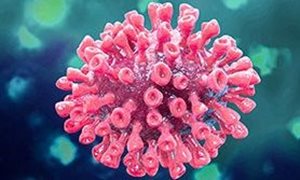23 April 2019
Thrombocytopenia and platelet dysfunction are commonly observed in patients with dengue virus (DENV) infection and may contribute to complications such as bleeding and plasma leakage. The etiology of dengue-associated thrombocytopenia is multifactorial and includes increased platelet clearance. The binding of the coagulation protein von Willebrand factor (VWF) to the platelet membrane and removal of sialic acid (desialylation) are two well-known mechanisms of platelet clearance, but whether these conditions also contribute to thrombocytopenia in dengue infection is unknown. In two observational cohort studies in Bandung and Jepara, Indonesia, we show that adult patients with dengue not only had higher plasma concentrations of plasma VWF antigen and active VWF, but that circulating platelets had also bound more VWF to their membrane. The amount of platelet-VWF binding correlated well with platelet count. Furthermore, sialic acid levels in dengue patients were significantly reduced as assessed by the binding of Sambucus nigra lectin (SNA) and Maackia amurensis lectin II (MAL-II) to platelets. Sialic acid on the platelet membrane is neuraminidase-labile, but dengue virus has no known neuraminidase activity. Indeed, no detectable activity of neuraminidase was present in plasma of dengue patients and no desialylation was found of plasma transferrin. Platelet sialylation was also not altered by in vitro exposure of platelets to DENV nonstructural protein 1 or cultured DENV. In contrast, induction of binding of VWF to glycoprotein 1b on platelets using the VWF-activating protein ristocetin resulted in the removal of platelet sialic acid by translocation of platelet neuraminidase to the platelet surface. The neuraminidase inhibitor oseltamivir reduced VWF-induced platelet desialylation. Our data demonstrate that excessive binding of VWF to platelets in dengue results in neuraminidase-mediated platelet desialylation and platelet clearance. Oseltamivir might be a novel treatment option for severe thrombocytopenia in dengue infection.
Publication
Quirijn de Mast is member of the theme Infectious diseases and global health.
 In the PLoS Pathogens Quirijn de Mast and his colleagues from the theme Infectious diseases and global health, showed that excessive binding of the coagulation protein von Willebrand factor leads to removal of sialic acid from platelets and platelet clearance.
In the PLoS Pathogens Quirijn de Mast and his colleagues from the theme Infectious diseases and global health, showed that excessive binding of the coagulation protein von Willebrand factor leads to removal of sialic acid from platelets and platelet clearance.
Thrombocytopenia and platelet dysfunction are commonly observed in patients with dengue virus (DENV) infection and may contribute to complications such as bleeding and plasma leakage. The etiology of dengue-associated thrombocytopenia is multifactorial and includes increased platelet clearance. The binding of the coagulation protein von Willebrand factor (VWF) to the platelet membrane and removal of sialic acid (desialylation) are two well-known mechanisms of platelet clearance, but whether these conditions also contribute to thrombocytopenia in dengue infection is unknown. In two observational cohort studies in Bandung and Jepara, Indonesia, we show that adult patients with dengue not only had higher plasma concentrations of plasma VWF antigen and active VWF, but that circulating platelets had also bound more VWF to their membrane. The amount of platelet-VWF binding correlated well with platelet count. Furthermore, sialic acid levels in dengue patients were significantly reduced as assessed by the binding of Sambucus nigra lectin (SNA) and Maackia amurensis lectin II (MAL-II) to platelets. Sialic acid on the platelet membrane is neuraminidase-labile, but dengue virus has no known neuraminidase activity. Indeed, no detectable activity of neuraminidase was present in plasma of dengue patients and no desialylation was found of plasma transferrin. Platelet sialylation was also not altered by in vitro exposure of platelets to DENV nonstructural protein 1 or cultured DENV. In contrast, induction of binding of VWF to glycoprotein 1b on platelets using the VWF-activating protein ristocetin resulted in the removal of platelet sialic acid by translocation of platelet neuraminidase to the platelet surface. The neuraminidase inhibitor oseltamivir reduced VWF-induced platelet desialylation. Our data demonstrate that excessive binding of VWF to platelets in dengue results in neuraminidase-mediated platelet desialylation and platelet clearance. Oseltamivir might be a novel treatment option for severe thrombocytopenia in dengue infection.
Publication
| Desialylation of platelets induced by Von Willebrand Factor is a novel mechanism of platelet clearance in dengue. |
| Riswari SF, Tunjungputri RN, Kullaya V, Garishah FM, Utari GSR, Farhanah N, Overheul GJ, Alisjahbana B, Gasem MH, Urbanus RT, de Groot PG, Lefeber DJ, van Rij RP, van der Ven A, de Mast Q. |
Quirijn de Mast is member of the theme Infectious diseases and global health.
Related news items

Epigenetics: Immunization is passed on to offspring Mice transmit adaptations to infections to next generations
19 October 2021 Does an infection affect the immunization of subsequent generations? It does, according to research now published in Nature Immunology. go to page
Q fever antibody does not predict disease progression
6 July 2021 Joint study by Radboudumc, Jeroen Bosch Hospital and UMC Utrecht. go to page
First Dutch professor of infectious disease outbreaks at Radboud university medical center
4 June 2021 Chantal Bleeker-Rovers about research on coronavirus, Q fever and other infectious diseases outbreaks go to page
Trained immunity: a tool for reducing susceptibility to and the severity of SARS-CoV-2 infection
17 February 2021 In a review in Cell Mihai Netea, Frank van de Veerdonk, Reinout van Crevel and Jorge Dominguez Andres propose that induction of trained immunity by whole-microorganism vaccines may represent an important tool for reducing susceptibility to and severity of SARS-CoV-2. go to page
Invasive fungal infections in influenza and COVID-19
8 July 2020 The Aspergillus fungus is found in the lungs of many COVID patients. A parallel occurs with influenza patients, who often develop a serious fungal infection. Although such a serious fungal infection seems to occur less frequently in COVID-patients, alertness remains necessary, go to page
